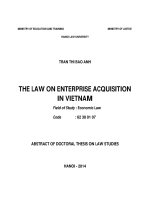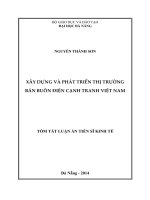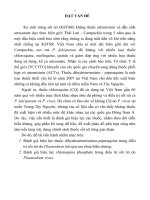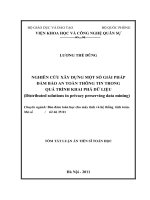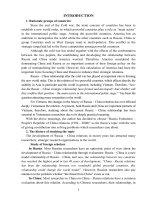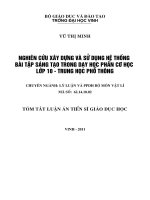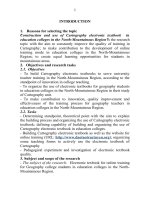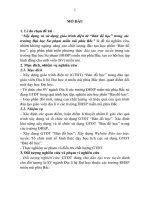tóm tắt luận án tiếng anh xây dựng và sử dụng giáo trình điện tử “bản đồ học” trong các trường đại học sư phạm miền núi phía bắc
Bạn đang xem bản rút gọn của tài liệu. Xem và tải ngay bản đầy đủ của tài liệu tại đây (589.52 KB, 26 trang )
1
INTRODUCTION
1. Reasons for selecting the topic
"Construction and use of Cartography electronic textbook in
education colleges in the North-Mountainous Region" is the
research topic with the aim to constantly improve the quality of
training in Cartography; to make contribution to the development of
online training mode in education colleges in the North-Mountainous
Region; to create equal learning opportunities for students in
mountainous areas.
2. Objectives and research tasks
2.1. Objectives
- To build Cartography electronic textbooks to serve university
teacher training in the North-Mountainous Region, according to the
standpoint of innovation in college teaching.
- To organize the use of electronic textbooks for geography students
in education colleges in the North-Mountainous Region in their study
of Cartography unit.
- To make contribution to innovation, quality improvement and
effectiveness of the training process for geography teachers in
education colleges in the North-Mountainous Region.
2.2. Tasks
- Determining standpoint, theoretical point with the aim to explain
the building process and organizing the use of Cartography electronic
textbook; defining capability of building and organizing the use of
Cartography electronic textbook in education colleges.
- Building Cartography electronic textbook as well as the website for
online training (URL: ); organizing
some teaching forms to actively use the electronic textbook of
Cartography
- Pedagogical experiment and investigation of electronic textbook
quality.
3. Subject and scope of the research
- The subject of the research: Electronic texbook for online training
for Geography college students in education colleges in the North-
Mountainous Region.
2
- The scope of the research: Building Cartography electronic
textbook for training secondary school teachers of Geography in
several education colleges and some training units in the North-
Mountainous Region.
4. Overview of historical research
4.1. A brief history of research and development of Cartography
- A brief history of research and development of Cartography in the
world;
- A brief history of research and development of Cartography in
Vietnam.
4.2. Summary of research and development of online training
- Summary of research and development of online training in the
world;
- Summary of research and development of online training in
Vietnam.
4.3. The formulation and use of Cartography electronic texbook in
the online training at the Pedagogical Colleges in Vietnam
- Can Tho University: Supporting system for teaching and learning "
Cartography", Website: ;
- Hanoi University of Education: Overview of Cartography textbook,
Website: ;
Those websites published the contents of Map Science only, not yet
the online training activities.
- Education colleges in the northern mountainous provinces: not yet
the online training deployment of Cartography study unit.
5. Research viewpoints and research methods
5.1. Research viewpoint
- Viewpoint of teaching technology
- Viewpoint of history
- Viewpoint of system
- Viewpoint territory
- Viewpoint of territory
- Viewpoint of active teaching
5.2. Research methods
- Meta-analysis
- Analysis of system
- Method of mapping
- Collecting, systematizing, and analyzing document
3
- Method of investigation, observation and pedagogical experiment.
- Method of using modern teaching technology.
- Method of summarizing experiences
- Method of statistical maths
6. New contributions of the thesis
- Defining the connection between Map Science – Online Training –
Learner as beneficiary, compare the two training modalities: traditional and
online with the aim to build the optimal mode for teaching Cartography.
- Building the electronic textbook of Cartography with new structured
program that meet training requirements of the credit-based system,
additional content of modern knowledge, rich document systems, visual
electronic lecture system, teaching-learning activities and learning
management system online.
- Organizing the use of Cartography electronic textbook for
geography students in education colleges in the Nothern
Mountainous Region; applying some active teaching methods from
exploiting Cartography electronic textbook.
- Deploying of teaching experiment, quality investigation of
electronic textbook.
7. The structure of the thesis
Apart from the Introduction, Conclusions, List of published
works, References, Appendixes; the content includes 3 chapters:
Chapter 1: Basis of theory and practice of the research topic
Chapter 2: Building and use of Cartography electronic textbook
Chapter 3: Pedagogical experiment
4
Chapter 1
BASIS OF THEORY AND PRACTICE
OF THE RESEARCH TOPIC
1.1. Cartography in bachelor program of geography for
educators according to credit-based system
1.1.1. Overview of Cartography
- Definition of Cartography: "Art, Science and Technology for
setting up a map, along with the results of research in this field as
the science documents and art works. In that context, all types of
maps, diagrams, charts and other indication forms, three-
dimensional model and the sphere that represents the Earth or any
celestial bodies, in any proportion, can be included".
- Study subjects of Cartography: Geographic maps and other cartographic
products.
- The mission of Cartography: studying the spatial structure,
reflecting the rules of geographical space system of phenomena,
natural objects, Social Economic in terms of distribution, correlation
and development process.
- Structure of Map Science: Basic theory of the map; Mathematics for
mapping; Map design and mapping; Map presentation; Print map; Use
Map; Economics organization of map production; Textbook of maps.
1.1.2. Some regulations of training in higher education under the
credit-based system
1.1.2.1. Essentials in higher education program
- Higher education program represent higher education target,
regulating standards of knowledge, skills, scope and structure of
higher education content, methods and forms of training, methods of
evaluation the training results for each module, discipline, training
level of higher education.
- The program is built on the basis of the frame curriculum issued by
the Minister of Education and Training.
1.1.2.2. The concept of training under the credit-based system: is the
training method in which students actively choose to study each module
to separately accumulate each subject, progress to complete the entire
training program.
5
1.1.2.3. Training programs under credit-based system: represents
higher education target, regulating standards of knowledge, skills,
scope and structure of higher education content, methods and forms
of training, methods of evaluation the training results.
1.1.2.4. Modulse and credits
1.1.2.5. Evaluation of the learning results
1.1.3. Bachelor training program in geography for educators under
credit-based system
1.1.3.1. Training Objectives: Include the goal of knowledge and skills
objectives
1.1.3.2. Framework program of training for pedagogical bachelors in
geography under credit-based system: Knowledge content for the whole
course: 132 credits (The contents of Physical Education (75 periods),
and the National Defense Education (165 periods) are not included).
1.1.4. The position of Cartography in the bachelor training
program for geography teacher under the credit-based system
- Cartography is a compulsory subject of Knowledge Base
- Compulsory class-time periods: 60 (In which: Theory: 45, Practice:
30), Self-study: 120
- Provide necessary knowledge for teaching geography in schools and
help students learn other subjects better.
1.2. Some basic teaching issues in higher education
1.2.1. The concept of teaching process in higher education is a
dynamic balancing system consists of three basic elements: scientific
knowledge, teaching and learning activities
1.2.2. The purpose of teaching at universities is to develop the
competence of creative activities for students at high levels; to formate
capacity of accessing issues; to equip with knowledge, culture, basic
skills, managing & organizing abilities.
1.2.3. Teaching duties in higher education is to equip with the
scientific knowledge system, development, to exercise creative
capacity, to form modern scientific methodology.
1.2.4. The nature of the teaching process in higher education is a
unique process of awareness of the research student.
1.2.5. Teaching method in higher education is activity manner,
sequence of coordination and interaction between teacher and learner
in order to implement successfully teaching and learning tasks
6
1.2.6. Teaching facilities in university are the tools that teachers and
students use in teaching process in order to form concepts, to train
tehniques & skills for students
1.3. Electronic Textbook
1.3.1. The concept of electronic textbooks
Electronic Textbook (GTDT) is a form of learning material, it is
compiled on the basis of application of ICT progress in the audio,
video and computer networks. The content of GTDT is subdivided
into units of knowledge and are scientifically arranged by hyperlinks.
Teaching methods are clearly presented in each unit of knowledge,
with special emphasis on self-study method of learning.
1.3.2. Necessary requirements of the electronic textbooks
- Content: Must be complete, at least as detailed as printed textbooks.
- The form: Need to coordinate documents, presentations (video,
PowerPoint , ) of the necessary parts. The exercises, tests should be
arranged by chapter, by each topic or general article, according to
different levels of difficulty.
1.3.3. The significance of of electronic textbooks
Ability to combine teaching facilities; Increased interaction between
students and tools; improve motivation for learning, personal
response, enhanced self-reliance, create personal learning
environment of learners; diverse & rich document links, The role of
the teacher in teaching using electronic textbooks towards a positive
change, repetitive nature of the Multimedia can replace the teacher in
a certain amount of time.
1.4. Some basic issues of online training
1.4.1. The concept of online training: Online training is a type of
training with the aim to implement the teaching & learning
objectives, in which there is a direct interaction between teachers and
learners as well as learning community conveniently through ICT.
1.4.2. The components of online training
1.4.2.1. System for building the lecture content is the product used to
support teachers to build online lecture content (CAS).
1.4.2.2. System for online learning management is the system used
to create, store, synthesize, and distribute online training content as
learning objects (LMS).
7
1.4.3. The standards of online training
1.4.3.1. The standard definition
"Standards are written agreements containing technical
specifications or other precise criteria to be used consistently as
rules, guidelines, or definitions of characteristics, to ensure that
materials, products, processes and services fit their purposes"
1.4.3.2. Online training standards: packing standard; information
exchange standard; quality standard.
1.4.3.3. The need for standards in the online training: Accessibility,
convertibility, adaptability, ability to reuse, sustainability, rationality.
1.5. The current status of teaching Cartography in education colleges in
the North-Mountainous Area
1.5.1. An overview of geography student at the education colleges in the
North-Mountainous Area
- Synthesis of student data: Total number of students surveyed: 1338,
in which: Ethnic minority students: 662 (make up 49%); Students in
particularly difficult areas: 439 (up 32,8 %); Students through
nomination and selection system, joint training, and “learning by
doing ": 677 (up 50,6 %).
- The relationship between psychological characteristics of the students,
quality of admission and teaching Cartography:
+ Advantages: Students eager to learn, have practical experience, should
be easy to connect from theory to reality, less dominated by the effects of
external social;
+ Disadvantages: Admission to geography is block C, so the "input"
knowledge might not meet the subject’s requirement. Level of IT of the
students is weak, the economic ground is low.
1.5.2. Assessment of the students’ actual learning and the need of
innovation of teaching methods
- Current status: it is common that the students take notes in the
class, not proactive, not regular contact with teachers, not participate
in the activities such as seminars, workshops, scientific research, has
not yet involved in writing of articles, nor online learning.
The needs for innovation of learning methods: Need to communicate,
to participate in activities such as seminars, workshops, study groups,
research, , and participation in online learning on the Internet.
8
1.6. Oriented reform of teaching method for Cartography at the
pedagogical colleges in the North-Mountainous Region
1.6.1. Scientific basis of innovative teaching methods at the colleges of
pedagogy:
The innovation of teaching methods in education colleges aims to
promote active, positive, and creative roles of the students in their
learning process at pedagogical colleges and in teaching at schools.
1.6.2. Orientations and measures to improve organizational forms
and methods of teaching at the colleges of Pedagogy
Teaching methods should highly promote positive, independent, and
creative students, make contribution to practising skills for students.
Learning methods of students consistent with the scientific research
method. Improvement of the testing & evaluation system of
knowledge and skills. Construction and optimal use of the conditions
and teaching facilities, especially ICT.
1.6.3. Orientation of teaching Cartography at the pedagogical colleges in
the North-Mountainous Region
The form of combining traditional classroom teaching with online teaching
has different levels:
+ Level 1: Traditional classroom teaching in parallel with the study
on the Internet.
+ Level 2: Teaching several modules on the Internet.
+ Level 3: Teaching some study units on the Internet.
- Teaching Cartography at level 1: teaching the class plays a key
role.
1.7. Determining the relationship between components in
teaching Cartography at the pedagogical colleges in the North-
Mountainous Region (Figure 1.3)
Figure 1.3. Diagram of relationship between the components
in building Cartography teaching mode.
Chapter 2
9
BUILDING AND USE OF ELECTRONIC TEXTBOOK
OF CARTOGRAPHY
2.1. Common issues in building Cartography electronic textbook
2.1.1. Objectives of building the electronic textbook of Cartography
- Training Geography teachers for secondary school.
- Teaching to meet the modern trend, towards the target of lifelong
learning, building a learning society;
- Improving the effectiveness of learning Cartography, creating a
modern learning environment, equality for students in mountainous
areas, opening a direction of teaching via the Internet;
- Helping students to effectively use information technology tools,
selecting & seeking information, actively planning and finding
appropriate learning methods.
2.1.2. Properties of the electronic textbook of Cartography
2.1.2.1. Scientific property: Ensuring the Cartology Science content
according to the framework program issued by the Ministry of
Education and Training, and supplemented with modern knowledge.
2.1.2.2. Inheritability: Inheritance of the Cartography textbooks that
have been used before.
2.1.2.3. Pedagogical property: Integrated in electronic textbook the
positive teaching methods. Suitable to students, consistent with the
purposes and requirements of the training process.
2.1.2.4. Aesthetic property: Electronic textbook meets the art
requirements of the courses content, and expressed in the appeal form.
2.1.3. Principles for building Cartography electronic textbook:
Combination of factors: Map science - Pedagogical property -
Modern technique, that are consistent with the real situation of the
students and the education colleges in the region.
2.1.4. Tasks of building electronic textbook of Cartography:
Positively innovate of teaching method, exploit the most activeness,
creativeness & initiative of students, applying of ICT progress in
teaching Cartography.
2.1.5. Criteria of building Cartography electronic textbook:
Clear learning objectives, accuracy of content, detailed; clear &
logical structure; the process of learning is expressed through specific
activities, ensuring multi-dimensional interactions between the
10
teacher - student, diverse resource of learning materials, reasonable
and updated, user-friendly interface, easy to use,
2.1.6. Some computer software used to build electronic textbook of
Cartography
2.1.6.1. Software E-Learning XHTML Editor is an open source
software, and is used to build lectures (CAS), it is intuitive and easy
to use. It provides the posibility for web publishing, easily reference
or integrate into the standard LMS compatible system.
2.1.6.2. Software Modular Object-Oriented Dynamic Learning
Environment (Moodle): is an information system, open source,
managing the teaching activities (Learning Management System -
LMS), creating courses on the Internet. Moodle's main functions:
Management (Web, users, courses); resources (lectures, document,
videos, ); online activities ("Chat", forum, testing, assessment,
survey, )
2.1.6.3. Software PowerPoint: is a means of visual presentation, and
is very effective in the process of teaching - learning.
2.1.6.4. Software Macromedia Captivate is specialized software for
creating interactive way and simulation as Flash animation (SWF)
and EXE.
2.2. Building Cartography electronic textbook
2.2.1. Design the outlines of Cartography electronic textbook
Credits: 4; Total class-time periods: 60, in which: Theory: 45;
Practice: 30; Self-study: 120 (as shown in the Table 2.2).
Table 2.2. Program structure of Cartography
Chapter
No.
Week Content Class time periods
Theory Practice Self-study
1 1 Cartography and geographical maps 4 0 8
2 2-4 Mathematical basis of the map 8 6 22
3 4-7 Cartographic language 8 6 22
4 7-8 Map generalization 3 0 6
5 8 Classification of geographical maps 2 0 4
6 9-10
Geographic maps with: Geographic
Information Systems, Remote
Sensing, Global Positioning System
4 4 12
7 11-12 Geo mapping 6 4 16
8 12-13 Use of geographic map 4 6 14
9 14-15 Textbook of map 6 4 16
Sum 45 30 120
2.2.2. Building the content of Cartography electronic textbook
11
Example: Chapter 3: Cartographic language
2.2.2.1. Overview of the cartographic language
Cartographic language shows specific space of objects
(phenomena) in the objective reality and its changes over time.
Expression of cartographic language is the notation on the map.
The basic function of language map:
- Displaying category (meaning) of the objects (phenomena);
- Reflecting the position and spatial relationships of objects
(phenomena);
- Expressing the quantitative & qualitative characteristics, changes
over time of the object (phenomenon).
2.2.2.2. Cartographic symbols
- Cartographic symbol is a means to express the information content
of the map, which shows the level of generalizion of the map content.
- Cartographic symbol is the notation system that has its own unique
structure, consisting of two components: the content (meaning), form
(graphic nature)
- Cartographic symbol is constructed from six types of graphic elements:
shape, size, orientation, color, brightness, and texture
- Characteristics of the Cartographic symbols: The content,
information, aesthetic, technical, and application.
- The key factors: syntax, semantic and pragmatic of the notation system.
2.2.2.3. Methods of map manifestation
- The method of symbols
- The method of line symbol
- The method of motion symbol
- The method of sum quantity
- The method of quality background
- The method of localization (regional distribution);
- The method of scoring.
- The method of contour line
- The method of position chart
- The method of Cartodiagram
- The method of Cartogram
* Notes in identification of methods of map expression
2.2.2.4. The colors in the map
12
- The role of color on a map: to increase the amount of information,
rich content, increasing the ability to distinguish, readability,
aesthetic, spatial, hierarchical classification of objects; to express
quantitative & qualitative features of the objects (phenomena).
- The theory of color: There are two types of color: colored color,
colorless color. The fundamental properties of colored color: color,
brightness, saturation.
2.2.2.5. Letters and notes on the map
* Purpose and meaning of words and notes on the map
- Are important components on a map, explaining the map content.
-
Writing (notes) on a map is divided into groups: name of the
geographical objects, notes of characteristics of the object, explaination
notes.
- Characteristics of the note text: Contrast, brightness, width, shape,
word direction, size, style.
- Properties of the note text on map: clearly readable, universal,
boldness, and art.
2.2.3. Building content "packages" of Cartography by eXe software
Example: Chapter 3: Cartographic language
2.2.3.1. Building the "Objectives"
- Theoretical objectives: Understand the characteristics of the method
of map display corresponding to the group, type of object on the
actual use; apply in the mapping and use; theory of color, using
colored colors on the map.
- Skill objectives: Identify and analyze the methods of map
indication, build simple map symbols; Improve aesthetics, art for
students.
- Enter the "Objectives": using iDevice Objective.
2.2.3.2. Building outline "tree" (headings)
- Use Outline: Adding a branch, changing a branch, deleting a
branch, changing the location of branches.
2.2.3.3. Entering content
- Enter the text as plain text using iDevice Free Text.
- Import images using iDevice Image with text.
- After entering the content into eXe, pack it coform SCORM
packaging standard.
13
2.2.4. Application of Moodle software to develop management
system and online teaching activities in Cartography electronic
textbook.
2.2.4.1. General information about the Cartography electronic
textbook: Name, content summary of textbook; some information
about the author, distribution table of the learning program,
announcement of the schedule, requirements of study for learner
(Figure 2.31).
2.2.4.2. Student management: The purpose is to manage students in
courses, including student lists, personal information of students in each
class (or group).
2.2.4.3. Building textbook resources
Building Textbook Resources containing the content of Cartography
study unit.
a) Putting the package Cartography content into Moodle: The
content packages posted to the Moodle system by typing
manipulation of content input.
b) Building electronic lectures of and put into Moodle
* Building electronic lectures includes the following steps: identifying
the basic issues, gather resources, complement, expand knowledge,
build script, script shows, checking, editing products.
* Putting electronic lectures into Moodle
2.2.4.4. Create links to reference material:
Actions: Home page → Add a resource → Link to a file or a website
→ Select and download a file / website (find the file/ website or
document to download), write the document title, document summary
→ save the changes.
2.2.4.5. Building and management of learning forum
- Forum is the place to raise and discuss topics (questions).
- The features of the forum: students search for information in forums,
write and read articles in the forum, reply to a (group of) people, send
attached files in Word, Excel, PowerPoint, format, provide statistic
figures on all posts to forums, sending exchange E-mail.
- The possibility of online training: Stimulate information sharing,
relevant to exchange of unorthodox information; creating excitement
for students through a discussion of the content in the electronic
textbook.
2.2.4.6. Using "Chat" tool
14
- "Chat" provides means to exchange information simultaneously.
- The features of "Chat" tool: personal (group) conversations, with
audio, video.
- Applicability of online training: Increase the ability of information
exchange and interest among the users.
To use, it is necessary to create a room for "Chat" (chat room), set up
time for logging in and meeting.
2.2.4.7. Check online objective testing
Objective testing is a method of testing and evaluating learning
outcomes of students with an objective multiple choice question
system. It is so-called objective because scoring (evaluating) is
entirely independent of the teacher who marks. "Cartography" uses
objective testing with four- option-questions (MCQ).
Table 2.8. Question distributing on a competence scale
No Content that needs to be
evaluated
Competence scale Total
ques-
tions
Know Under-
stand
Application
Low
level
High
level
1 Chapter 1. Cartography and
geographic maps
15 15 5 5 40
2 Chapter 2. Mathematical basis of
maps
20 20 10 10 60
3 Chapter 3. Language of maps 20 20 10 10 60
4 Chapter 4. Map generalization 8 8 5 4 25
5 Chapter 5. Geographic map
classification
8 8 5 4 25
6 Chapter 6. Geographic maps with:
geographic information systems
(GIS), remote sensing (RS),
Global Positioning System (GPS)
20 20 5 5 50
7 Chapter 7. Geographic mapping 10 10 5 5 30
8 Chapter 8. Using geographic
maps
20 20 10 10 60
9 Chapter 9. Textbook maps 10 10 15 15 50
Total 131 131 70 68 400
Percentage 32,7 32,7 17,6 17,0 100%
- Tools for creating online tests are applications that help teachers
create and distribute tests, questions on the Internet, reviews and
reports.
- Distribute questions for chapters on a scale of different competence:
Know: Reconstructs the learned knowledge, Understand: analyze the
learned knowledge, Application 1: creative analysis, Application 2:
discovery of new problems. (Table 2.8)
15
- Create online tests
+ Method 1: compile test by some software of question compiling,
and then upload on the Moodle system.
+ Method 2: compile directly on the management system.
After completion of submission, the system will inform the total
points and specific points for students.
2.2.4.8. Activity of doing homework
- After each chapter, implement doing homework (individually or in
groups).
- Requirements: test questions have open the characteristic, and are
presented as essays.
- Teachers give topics (questions) for learners individually or in
groups, set up deadlines for submission, set up scores.
2.2.4.9. Systems of learners’ score management
- Managing scores helps teachers capture, synthesize learners’ scores
to conduct classification and evaluation of learning outcomes, and
then have timely adjustments in teaching. Scores are expressed in
formats of Excel, text, charts.
- Learners’ scores are obtained from scores for homework, tests,
forums, attendance, etc. implemented by the automated system.
2.3. Using electronic textbooks of "Cartography"
2.3.1. Log in online training system of “Cartography”
2.3.1.1. Register and validate account
Step 1: Sign up
Step 2: Verify account via E-mail
2.3.1.2 Log in the system and take part in courses
Read information and schedules instructed by the teachers. Read the
package of related lectures. Read materials (including web pages,
files, and software applications) which have been available in the
chapter link. Participate in activities: forums and creating forums,
participate in "chat rooms" and participate in making assignments
(individually or in groups) under the administration of teachers.
Conduct periodic inspection to assess the level of self acceptance and
participate in examinations of ending credits or courses to get points
2.3.2. Some forms of active learning using the electronic textbook
of "Cartography"
2.3.2.1. Discussion
Discussing is an organizational form with the style of discussing
16
around a number of topics which have been prepared under the
guidance of teachers. Students who participate in discussions
prepared comments on the issues teachers required, questions, and
solutions of individuals or groups, performed on the Internet.
2.3.2.2. Co-operative Teaching (Co-operative Learning)
- Co-operative teaching is a form of teaching in which groups of
students work together solving problems, drawing knowledge under
the guidance of teachers in the use of tools such as "forums", "Chat",
E- mails.
Co-operative teaching requires a combination of elements: personal
responsibility, group sharing, communication skills, cooperative
process assessment, conduction of interactive activities, etc.
Example: Co-operative teaching of "methods of map expression" -
Divide students into 11 groups to learn 11 subjects, then discuss and
synthesize the results (Figure 2.51)
Figure 2.51. Chart of teaching based on method of cooperation
2.3.2.3. Split Teaching
Teachers classifies students into groups, depending on the ability of
each group to make exercises and discussion topics. Organize
interactions among students to exchange and form habits of self-
assessment, self-adjustment for each student.
For example, organize the class into four groups with four topics
2.3.2.4. Programmed Teaching
Programmization essentially means splitting the teaching content into
units of knowledge which are closely related to each other. The
17
movement to the next stage of learning depends on the quality of
perceiving from the earlier period.
2.3.2.5. Training pedagogical skills for students
- Relate the program of "Cartography" with high school knowledge
of geography
- Improve the utility of modern teaching equipment
- Practice your ability of self- learning, independent thinking, team
working
- Access, and use, then proceed to apply online teaching.
2.4. Comparison between traditional training and online training
of “Cartography"
2.4.1. The purpose of comparison between two training methods
- To determine the relationship, and compare the difference between
the two methods of training
- To identify strengths and limitations of each method, then draws
from that the optimal solution for teaching "Cartography".
2.4.2. Comparison between two training methods
Table 2.10. Comparison of common problems
of two training methods
Elements Traditional training Online Training
Space for
teaching,
learners
-Classrooms with limited size
-The number of students is
limited, certain and focused
-Qualifications and age are
relatively equal
-No limit in space
-The number of students is not limited or
certain, and from different places
-Qualifications and age are unequal
Plan for
teaching-
learning
-Synchronous for students based
on the common plan of the school
-Students go to class regularly for
each day
-Learning progress for the whole
class
-The plan is actively arranged by students
under the guidance of teachers
-Time for learning is optional and unfixed
-Learning progress for each student can be
shortened or lengthened based on schedules
Teaching
facilities
-Traditional and modern teaching
facilities (teaching software,
projectors, overheads, video,
audio, etc)
-Multimedia environment: emulation. Video
television, links on the Internet, etc.
Teaching
environment
There is a direct contact between
teachers and students in class
There is an indirect contact between
teachers and students through the Internet
Preparation
for teaching
- learning
-Teachers compile lessons, set up
teaching scenarios based on
available textbooks, compile
materials, and prepare teaching
facilities (traditional and modern).
-Teachers design electronic textbooks, and
electronic lectures. Combine teaching
methods in electronic lectures by using
information technology and
telecommunication for designing lectures
18
Combine teaching methods
during the lecture.
-Students prepare textbooks,
materials, traditional and modern
facilities for direct use in class.
(PowerPoint, video, etc), link to materials, build
online activities: forums, seminars, etc. Make
learning plans for students and upload on the
Internet, etc.
-Students prepare computers with Internet
connection. Prepare necessary conditions when
participating the course: create personal e-mail,
log in the system, make detailed learning plans
for individuals in each module and the whole
course.
The process
of teaching
-Teachers teach based on the
prepared lesson plan which uses
the teaching methods as lectures,
talks, seminars, problem raising
teaching method, group
activities These methods
happen directly in class. Tools are
images, audios, practical
activities,
-Students study in class based on
the lesson plan by teachers, take
part in direct activities in class or
practical ones.
-Teachers monitor and executive the course
on the Internet: manage, group students,
executive forums, answer questions,
generalize comments and give conclusions.
Assign students/groups of students
-Students actively read the content in
electronic textbooks via packages of content
in files as Text, video, PowerPoint, flash,
etc., which are available in electronic
textbooks (possibly re-learn or skip any
content ). Take part in online activities:
forums, “chat”, seminars, etc, with online
community.
Activities of
inspecting,
evaluating
learning
outcomes
-Forms: through activities,
objective tests, free essays,
exercises, etc
-Time: periodic, limited number
of times
-Organization: focused check
with close inspection
-Periodically inform learning
outcomes
-Forms: through activities, objective tests,
free essays, exercises, etc, on the Internet
-Time: students actively arrange (permitted
period of time), unlimited number of times
-Organization: unfocused check without
inspection, depending on students’ self-
consciousness
-Usually inform timely learning outcomes
for students self assessment and self-
adjustment.
Practical
activities
-Students contact and work
directly with equipment for
practice
-Participate in outdoor activities
-Join the virtual exercises (see video,
animation )
-Participate in the activities of virtual reality
Fostering
skills, and
pedagogical
skills
-Students directly learn
pedagogical skills from teachers
-Teaching methods are diversified
, practical and confirmed in
advance
-Practice pedagogical skills on
real human subjects
-Students do not directly learn pedagogical
skills from teachers
-Some modern teaching methods are
integrated in electronic textbooks exploited
by students under the guidance of teachers
and curricula. Highly encourage students’
activeness and independence
2.4.3. Reviews (online training vs. traditional training)
- Strengths: express flexibility, personal compatibility, and learning
materials are diversified and always updated, contributing to practice
19
skills and learning attitude; increase memorizing ability; tightly
manage the learning process of students.
- Limitations: Not effective in teaching difficult content; limit some
practical skills of “Cartography”, reduce communication skills, a love
for career from teachers to students; un-control the test subjects;
increase the amount of work for teachers, build the electronic textbook
“Cartography” more difficultly and expensive than tradi- tional
textbooks; increase the costs of facilities and Internet access, etc.
Chapter 3
PEDAGOGICAL EXPERIMENT
3.1. Experimental teaching
20
3.1.1. Experimental teaching purposes
- To clarify the issues of theory and practice.
- To evaluate the appropriateness of the research thesis to the trend of
innovative teaching methods.
- To be a basis for application to other subjects.
3.1.2. Principles for conducting experiments
- On many subjects of different grades of students.
- The results are evaluated objectively, scientifically with the
comparison between experimental and control classes.
3.1.3. Experimental tasks
- Draw advantages and disadvantages of teaching methods.
- Transfer knowledge, methods of management, administration,
modern teaching activities for students on the Internet.
3.1.4. Experimental content: All of the program of "Cartography".
3.1.5. Experimental organization
3.1.5.1. Select the school and classroom for experiments (Table 3.1)
Table 3.1: Number of students FOR experiment in training units
Training
Unit
Experiments control
Class Number
of
students
Subjects
of
priority
Class Number
of
students
Subjects
of
priority
Thai
Nguyen
College
of
Educatio
n
Geography
of Course
43A
74
(100%)
44
(59%)
Geography
of Course
43C
66
(100%)
38
(57 %)
Geography
of Course
44A
68
(100%)
27
(40%)
Geography
of Course
44B
64
(100%)
28
(43%)
Ha Giang
(joint
training
Geography
of Course
1B
69
(100%)
30
(43%)
Geography
of Course
1A
70
(100%)
30
(43%)
Total 211
(100%)
101
(48%)
200
(100%)
96
(48%)
3.1.5.2. Organizing of Experiment
- Experimental class: Conducting the parallel instruction: teach in
class under the general schedule of the college and online teaching on
21
the Internet using electronic textbook of "Cartography". Time for
learning on the Internet is actively arranged by students but durations
regulated by teachers must be specified (occupying 90 periods out of
120 periods of self-learning). The process of online teaching in
combination with teaching in class is done according to the scenario
set by teachers for each module.
- Control class: ordinarily teaching with the traditional classroom
method.
- End module Test: doing the same for the experimental and control
subjects.
3.1.6. Evaluation of experimental results
3.1.6.1. Synthesize experimental results (Table 3.3)
3.1.6.2. Chart learning outcomes on a scale of letters
Figure 3.2. Chart of learning outcomes on a scale of letters
3.1.6.3. Cumulative frequency diagram
Figure 3.1. Charts of the cumulative frequency
Table 3.3. Statistics of points (scores) of the experimental
and control classes
22
3.1.6.4. Calculate the statistical parameters
3.2. Survey of ideas of experts, teachers, students on the
electronic textbook of "Cartography" and the effectiveness of
combined teaching methods
3.2.1. Purposes of surveys
- To collect opinions of assessment on strengths and limitations of
electronic textbooks.
- To collect ideas of self-assessment on perceiving expertise, the
ability to exploit information, the ability to use computers in online
learning of students.
- To summarize recommendations and proposals.
3.2.2. Audience for surveys
- Total number of teachers surveyed: 81; including: Dr.: 11, Master:
68, Bachelor: 02.
- Number of students: 271.
3.2.3. Synthesize survey results
3.2.4. Conclusion after surveys
- General comments: good textbook
- The ability to use computers, the ability to exploit electronic
textbooks; Internet serving for students’ learning are improved
remarkably.
23
Table 3.5. Summing up the opinions of experts,
teachers, high school teachers who evaluate
electronic textbook of "Cartography"
No. Content for evaluation
Evaluating level
(%)
fairly average good excellent
1
Scientific
characteristics
Ensuring scientific content of
maps
0 0 31,0 69,0
Structure of the electronic
textbook of “Cartography”
0 2,5 26 71,5
Meeting the frame curriculum 0 0 13,5 86,5
Meeting the credit- training
program
0 0 16 84
2
Pedagogical
characteristics
Appropriate to mountainous
students
2,5 18,5 57 22
Appropriate to combined
teaching
0 0 27 73
Creating interest in learning and
teaching
0 6 42 52
Integrating modern teaching
methods
0 0 18,5 81,5
Characteristics of sensitive
beauty of the text book
0 4 52 44
3
Application of
information
technology
and
telecommunic
ation
Levels of software exploiting
and using
0 0 49 51
Ability of exploiting and
linking on the Internet
0 0 25 70
4
Characteristic
of reality
Appropriate to the real
situations
0 7,5 55,5 37
Appropriate to high school
teacher training
0 12 76 12
Feasibility in colleges of
education
0 0 18,5 81,5
24
CONCLUSIONS AND RECOMMENDATIONS
1. Conclusion
Research results
- Studying the way to approach the credit-based bachelor training
program of Geography in education colleges
- Defining the basis of argument and practice for building electronic
textbook.
- Orienting to building Cartography electronic textbook in the credit-
based bachelor training program of Geography in education colleges,
in order to make effective use in teaching students in mountainous
areas.
- Building relationships between components of online teaching in order
to determine the position and importance of each component in the
system. Comparison of the two modes: traditional method of training
and online training, and proposed training model of combining the
traditional classroom teaching with the online teaching "Cartography"
study unit.
- Building the "Cartography" electronic textbook including: 09
lecture modules (total 60 class time periods) that are well structured,
logical, intuitive and easy to use; Reference document’s abundant
and updated; The objective testing system includes 400 questions,
and major assignments that include the whole program; the seminar
activities, forums, chat to help the student to study better; The
management and operation system for online courses to create good
conditions for teaching staff to administer their students, and students
can grasp their study program quickly and accurately. A number of
active teaching methods are integrated in the electronic textbook.
-Building the website for online teaching:
http//www.daotaotructuyen.org/
- Deploying experimental teaching for students in the mountainous
areas and carrying out the surveys to find out the professionals,
teachers and students’ ideas to come to the conclusion: the electronic
textbook is suitable for teaching "Cartography" in the pedagogical
colleges in the North- mountainous Regions.
2. Recommendations
- Study and develop online teaching in other scientific disciplines.
- Make admissions for sector of Geography- block A
(Mathematics, Physics, Chemistry).
- Strengthen infrastructure, computer training for schools in the
northern mountainous region.
3.The ability to develop the theme: Continue to improve the research
towards the research and development of electronic textbooks for many
other subjects and disciplines that could be applied on a national scale.
LIST OF PUBLISHED PAPERS
25
A. ARTICLES
1.Do Vu Son (2005), Improving the application og Information
Tecnology and Telecommunication in study and scientific research of
the students in Thai Nguyen College of Education, Summary Record:
Application of Information Technology in studying, managing and
teaching the students in national colleges, Hanoi, April 15, 2005.
2. Do Vu Son (2005), "Building the electronic lecture – textbook of
“Cartography”. Journal of Education, 121, p: 41-43.
3. Do Vu Son (2006), "Enhancing the understanding of General
Cartography in teaching Geography for high school teachers and
pupils”, Journal of Education, 144, p: 22-23.
4. Do Vu Son (2006), Designing the electronic lecture – textbook of
Advanced Geography - grade 10 (Cartography), National
Conference of Science and Technology on improving the quality of
training teachers and educational managing staff, Thai nguyen,
October, 21-22, 2006, p: 213-218.
5. Do Vu Son (2008), "Exploiting the information system of
Geography GIS and Mapinfo software in designing the electronic
lectrure of General Cartography”, Journal of Education, 191, p: 32-
34.
6. Do Vu Son (2010), "Building a system of inspecting and
evaluating the learning outcomes in the electronic textbook of
Cartography used for online training”, Thai Nguyen Journal of
Science and Technology, 66(4), p: 29-31
7. Do Vu Son (2010), Building and implementing online training of
Cartography. Summary Record of National Scientific Seminar in
Geography V, Hanoi, June 19-20, 2010.
8. Do Vu Son (2010), "Exploiting Moodle sorftware in online
training, the credit of Cartography in the College of Education”,
Journal of Education, 241, p: 41-42.
9. Do Vu Son (2010), "The application of software of E-learning
XHTLM (eXe) to build the course content, the credit of Cartography
used for online training”, Thai Nguyen Journal of Science and
Technology, 69(7), p: 119-123.
10. Do Vu Son (2010), "Learning method of Geographical students in
colleges of education in the northern mountainous areas and online
training of Cartography”, Thai Nguyen Journal of Science and
Technology, 70(8), p: 15-18.

